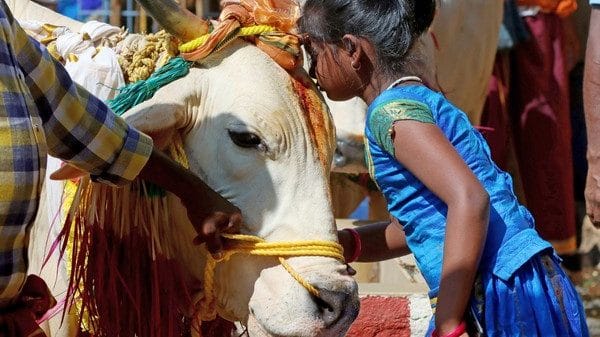With the murder of two Muslim men, Junaid and Nasir, in Haryana, allegedly by members of the Bajrang Dal, the issue of cow vigilantism and mob lynching is back into public debate. While it is necessary that we address hatred against minority communities, Indians have a tendency to see such instances only through the hate crime angle and ignore historical reality. The issue has always been politicised and Hindu sentiments attacked for centuries. Moreover, mob justice mentality rules the common Indian mind.
Mob lynching and violence in the name of cow protection are not uncommon in India — they must be seen within their historical context. Through the centuries, the cow acquired a sacred status in Indian religions such as Hinduism, Jainism, Buddhism, and Sikhism. Even before the British era, cow protection was politicised — Mughal emperor Akbar banned cow slaughter and Bahadur Shah Zafar threatened to execute any Muslim caught sacrificing cows during Eid-al-Adha. This sentiment toward protecting cows turned into a movement later on. Activism around the issue can be traced to the 1872 Kuka movement led by Namdhari Sikhs of Punjab, long before M.K. Gandhi took up the cause in the 1920s.
While the movement gained momentum among many Hindus, a section of Muslims saw it as an affront to their right to religious freedom. This deepened the rift between the two communities.
And violence was as much a part of cow protection movement/activism at that time. The 1714 Holi riot in Ahmedabad was partly rooted in the same cause. Then there were the 1893 riots in Mumbai and Azamgarh during Eid al-Adha. There was a repeat of these riots in 1894, and these were recorded as the largest riots in British India after the 1857 revolt. Between 1900 and 1947, there were many instances of anti-cow slaughter riots in India — particularly around Eid al-Adha. Hundreds were arrested, and both Hindus and Muslims suffered. Such riots, though lesser in number, occurred even after Independence in Uttar Pradesh, Delhi, and Kolkata.
Today, while a large number of victims of cow vigilantism violence are Muslims, some Hindu groups aren’t immune to it either — Dalits have been assaulted and beaten up over suspicions of cow slaughter. In 2016, four Dalit men were publically beaten up by cow vigilantes in Gujarat’s Gir Somnath district for allegedly slaughtering a cow. In 2002, a mob lynched five Dalit men to death in Haryana’s Jhajjar district over similar accusations. According to a Human Rights Watch report, a total of 44 cow vigilante killings occurred in India between May 2015 and December 2018.
Also read: Shashi Tharoor: It seems safer in many places to be a cow than a…
The larger problem
The problem of mob justice in India, though, extends beyond cow protectionism. According to Mumbai-based nonprofit IndiaSpend, between January 2017 and July 2018, there were 69 reported cases of mob violence over child-lifting rumours. Such instances are symptomatic of a larger problem in India’s law and order system. Common people don’t trust institutions to deliver justice in time or think that law is a real deterrence to crime. Along with the failure of the system, people don’t understand the concept of retributive or restorative justice and its importance, and why trials and appropriate punishments are necessary.
Moreover, we need to understand and address the political agendas and propaganda put forward by various stakeholders. Religious hate crime is a reality in India. People from various religious communities commit crimes over sentimental hurt — be it Muslims killing Hindus due to blasphemy (remember the June 2022 beheading of Kanhaiya Lal in Udaipur?) or angry Sikhs beating Hindus (in 2021, a Hindu was beaten to death in Amritsar’s Golden Temple for committing ‘sacrilege’). Till we keep pointing fingers at one or the other community, we will not find a solution. There should be a sense of fairness while addressing such crucial issues. To properly tackle the issue of mob violence, we need legislative, police, and judiciary reforms along with awareness about the consequences of mob justice.
Our concern should extend to the real victims and we must ensure justice is delivered, not reduce it to identity politics and power dynamics.
(Edited by Humra Laeeq)






